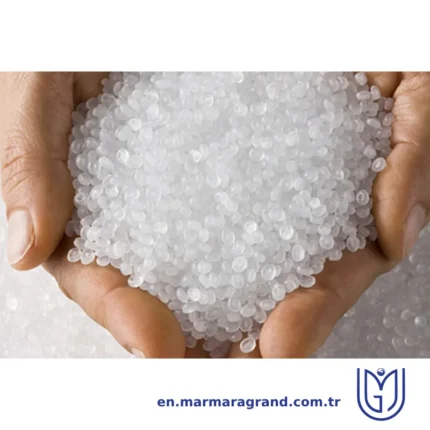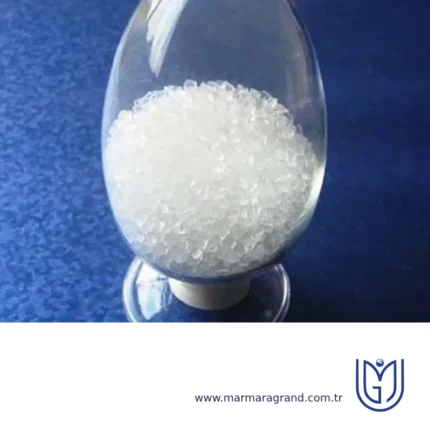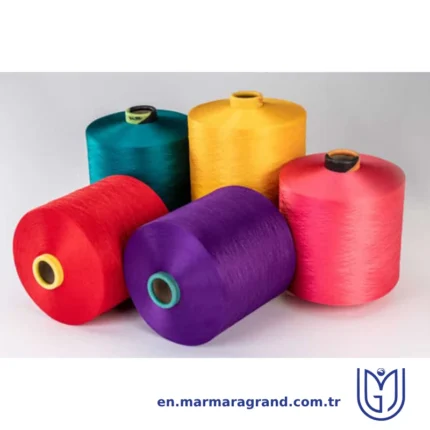Bottle Grade
Polyethylene Terephthalate (PET) is a versatile thermoplastic polymer widely used in the packaging industry, particularly for bottle manufacturing. PET bottle-grade resin is a specialized type of PET formulated to meet the requirements of beverage, food, and pharmaceutical packaging. One of the key advantages of PET bottle-grade material is its food-safe quality, ensuring compliance with global regulatory standards like those set by the FDA (Food and Drug Administration) and EFSA (European Food Safety Authority). With growing concerns about sustainability, PET bottle-grade materials are evolving to incorporate higher percentages of recycled content while maintaining their structural integrity and safety.
1.StructurePET (Polyethylene Terephthalate) is a semi-crystalline thermoplastic polymer belonging to the polyester family. The structure of PET bottle-grade material is based on long-chain polymer molecules formed through polycondensation of terephthalic acid (TPA) and ethylene glycol (EG). The repeating unit in PET is: {-O-CH_2-CH_2-O-CO-C_6H_4-CO-} This structure consists of:
- Ester groups (-COO-) → Provide flexibility and durability
- Benzene rings (C₆H₄) → Contribute to rigidity and strength
- Ether bonds (-O-) → Help in processability and thermal stability
2.PropertiesPET (Polyethylene Terephthalate) bottle-grade resin possesses a unique combination of physical, mechanical, thermal, chemical, and barrier properties, making it the preferred material for beverage and food packaging. It is highly transparent, lightweight, and has a smooth surface, providing an attractive and glossy finish for bottles. Mechanically, PET is strong, tough, and resistant to impact and stress-cracking, ensuring durability during handling and transportation. Its flexibility allows easy molding into various bottle shapes while maintaining high stiffness for structural integrity. Thermally, PET has a glass transition temperature of approximately 75–80°C and a melting point of around 250–265°C, making it stable under moderate heat conditions. Chemically, it exhibits excellent resistance to acids, oils, and solvents while maintaining hydrolytic stability in humid environments. Additionally, PET is non-toxic and food-safe, meeting regulatory standards such as those set by the FDA and EFSA. Its superior barrier properties help preserve the quality of packaged products by limiting oxygen and carbon dioxide permeability and preventing moisture absorption.A key advantage of PET bottle-grade material is its recyclability, as it is 100% recyclable and can be processed into recycled PET (rPET), promoting sustainability and reducing environmental impact. These properties collectively make PET an ideal choice for water bottles, soft drink containers, juice packaging, and other consumer goods that require clarity, strength, and food safety.
3. Applications of Bottle Grade PETBottle-grade PET is used across multiple industries due to its versatility and safety.
1. Food & Beverage Industry
Soft Drink & Water Bottles – Carbonated and non-carbonated beverages Dairy & Juice Containers – Milk, yogurt drinks, and fresh juices Edible Oil & Condiment Packaging – Cooking oils, sauces, and vinegar2 Pharmaceutical & Healthcare
Medicine Bottles – Liquid syrups and vitamin supplements Personal Care Packaging – Shampoo, lotion, and cosmetic containers3 Industrial & Chemical Applications
Household & Industrial Chemicals – Detergents, cleaning agents, and solvents Laboratory Containers – Sterile packaging for chemicals and reagents4 Sustainable Packaging & Recycled PET Products
Recycled PET Bottles – Used in textiles, automotive parts, and reusable packaging Eco-Friendly Packaging – Biodegradable and sustainable bottle solutions4. Advantages of Bottle Grade PETBottle-grade PET offers multiple benefits, making it the preferred material for packaging. Cost-Effective: Lower production costs compared to glass and metal Shatterproof & Durable: Reduces breakage risks in transportation and usage Lightweight: Decreases shipping weight and carbon footprint Versatile & Moldable: Easily shaped into different bottle designs Safe for Food Contact: Approved by FDA and EFSA for direct food and beverage use Eco-Friendly: Supports recycling and sustainable initiatives
5. Disadvantages of Bottle Grade PETDespite its benefits, bottle-grade PET has some drawbacks: Environmental Concerns: Improper disposal leads to plastic pollution Heat Sensitivity: Deforms at high temperatures, limiting hot-fill applications Gas Permeability: Less effective than glass in preventing oxygen ingress Chemical Leaching (Low Risk): May release trace amounts of antimony oxide under extreme conditions Recycling Challenges: Requires advanced sorting and processing to maintain quality
Ethylene TetraFluoroEthylene (ETFE)
Ethylene Tetrafluoroethylene (ETFE) is a high-performance fluoropolymer known for its exceptional strength, lightweight nature, and resistance to environmental conditions. It was originally developed as an insulating material for the aerospace industry but is now widely used in architectural and industrial applications.
Structure
Ethylene Tetrafluoroethylene (ETFE) is a copolymer composed of ethylene (C₂H₄) and tetrafluoroethylene (C₂F₄) units. Its molecular structure consists of a repeating chain of carbon atoms bonded to both fluorine and hydrogen atoms, giving it a unique combination of chemical resistance, mechanical strength, and thermal stability. The presence of fluorine atoms enhances its non-stick properties and high resistance to UV radiation, while the ethylene component contributes to its flexibility and toughness. Unlike polytetrafluoroethylene (PTFE), ETFE has a lower fluorine content, making it slightly less chemically inert but significantly stronger and more impact-resistant. This structural composition results in a lightweight, durable material that retains its transparency and mechanical properties even under extreme environmental conditions. ETFE's semi-crystalline structure also allows it to be processed into thin films, making it highly suitable for architectural applications, insulation, and protective coatings.Properties
Ethylene Tetrafluoroethylene (ETFE) possesses a unique combination of properties that make it highly versatile across various applications. It is exceptionally lightweight, weighing only about 1% of the weight of glass, while maintaining high tensile strength and impact resistance. Its chemical structure provides outstanding resistance to ultraviolet (UV) radiation, weathering, and most chemicals, ensuring long-term durability in harsh environments. ETFE is highly transparent, allowing up to 95% of natural light to pass through, making it an excellent choice for architectural applications. Additionally, it has a low coefficient of friction, giving it self-cleaning and anti-fouling properties. The material is also highly flexible, capable of stretching up to three times its original length without losing integrity. With a high melting point of around 265°C (509°F), ETFE exhibits excellent thermal stability and can withstand extreme temperature fluctuations without degradation. Furthermore, it is a recyclable material, adding to its sustainability by reducing environmental impact. These combined properties make ETFE a preferred choice for applications in construction, aerospace, medical, and renewable energy industries.Advantages
• Lightweight: Weighs only about 1% of the weight of glass. • High Strength & Durability: Resistant to mechanical stress, impact, and punctures. • Transparency: Allows up to 95% natural light transmission. • UV & Weather Resistance: Does not degrade under prolonged sunlight exposure. • Chemical Resistance: Withstands most acids, solvents, and other harsh chemicals. • Self-Cleaning Surface: Low friction and non-stick properties prevent dirt accumulation. • Thermal Stability: Can withstand extreme temperatures (-185°C to 150°C). • Flexibility & Elasticity: Can stretch up to three times its length without damage. • Eco-Friendly & Recyclable: Can be melted down and reused.Disadvantages
• Higher Cost: More expensive than traditional materials like glass or polycarbonate. • Flammability Concerns: Can burn under extreme conditions but is self-extinguishing. • Limited Structural Support: Needs additional framing or inflation systems for strength. • Softness & Scratch Sensitivity: Can be scratched more easily than glass. • Noise Insulation: Provides less soundproofing compared to solid materials.Applications
• Architecture & Construction: Used in stadiums, skylights, and domes (e.g., Allianz Arena, Eden Project). • Aerospace & Automotive: Used for wire insulation and protective coatings. • Medical Industry: Used for tubing, catheters, and biocompatible coatings. • Chemical Industry: Lining for pipes and tanks due to its chemical resistance. • Solar & Renewable Energy: Used in photovoltaic panel coatings and greenhouse covers. • Electronics: Used in high-performance cable insulation for aerospace and telecommunications.Textile Grade
Textile grade refers to materials that are specifically designed and processed for textile applications, ensuring optimal performance in fabric production. These materials can be natural (like cotton, wool, silk) or synthetic (like polyester, nylon, acrylic).
- Molecular Structure:
- Natural fibers have a cellulose-based (plant fibers) or protein-based (animal fibers) molecular structure.
- Synthetic fibers are often derived from polymer chains, such as polyethylene terephthalate (PET) in polyester.
- Fiber Morphology:
- Fibers are classified as filament (long, continuous fibers like silk) or staple (short fibers like cotton).
- Processing techniques such as spinning, weaving, and knitting alter fiber orientation for enhanced strength and flexibility.
- Surface Treatment:
- Textile grade materials undergo chemical treatments such as dyeing, anti-static coating, moisture-wicking finishes, and UV protection to enhance their functionality.
PropertiesTextile grade materials possess distinct characteristics that make them suitable for various applications:
1. Mechanical Properties
✔ High Tensile Strength – Ensures durability and resistance to tearing. ✔ Elasticity – Some fibers (like spandex) stretch and recover their shape. ✔ Abrasion Resistance – Important for heavy-use applications like upholstery and workwear.2. Thermal Properties
✔ Heat Resistance – Some fibers (e.g., aramid, wool) withstand high temperatures. ✔ Low Melting Point – Certain synthetics (e.g., polyester) require controlled heat processing.3. Chemical Properties
✔ Moisture-Wicking – Polyester and nylon repel moisture, keeping fabrics dry. ✔ Chemical Resistance – Some textile grades resist acids, alkalis, and solvents. ✔ UV Protection – Certain fibers (e.g., acrylic) naturally block UV rays.4. Environmental Properties
✔ Biodegradability – Natural fibers decompose over time, unlike synthetics. ✔ Sustainability – Eco-friendly textile grades include organic cotton, recycled polyester, and bamboo fibers.ApplicationsTextile grade materials are used across multiple industries, including fashion, home textiles, and technical applications.
1. Apparel Industry
- Clothing – Shirts, pants, jackets, and sportswear.
- Performance Fabrics – Moisture-wicking athletic wear, compression garments.
- Luxury Textiles – Silk, high-thread-count cotton, and premium synthetic blends.
2. Home Textiles
- Upholstery – Durable fabrics for sofas, curtains, and carpets.
- Bedding – Sheets, blankets, and pillowcases.
- Towels & Linens – Cotton-based materials for comfort and absorbency.
3. Industrial & Technical Textiles
- Automotive Textiles – Car seats, airbags, and interior linings.
- Medical Textiles – Surgical gowns, bandages, and antimicrobial fabrics.
- Protective Gear – Fire-resistant clothing (e.g., Nomex), bulletproof vests (Kevlar).
4. Eco-Friendly & Sustainable Applications
- Recycled Textiles – Upcycled polyester from plastic bottles.
- Organic Fibers – Bamboo, hemp, and organic cotton for sustainable fashion.
AdvantagesDurability – Textile grade materials are engineered for longevity. Versatility – Suitable for various applications, from fashion to industry. Lightweight & Comfortable – Many textiles are breathable and easy to wear. Easy Maintenance – Many fibers resist stains, wrinkles, and shrinkage. Cost-Effective – Mass production of synthetics reduces costs. Sustainability Options – Growing availability of eco-friendly textile grades.
DisadvantagesEnvironmental Concerns – Many synthetic fibers are non-biodegradable and contribute to plastic pollution. Flammability – Some textiles require fire-resistant treatments for safety. Chemical Sensitivity – Certain materials degrade when exposed to strong detergents, acids, or UV light. Heat Sensitivity – Synthetic fibers like polyester melt at high temperatures, limiting ironing options. Moisture Absorption Issues – Some fibers retain or repel moisture excessively, impacting comfort.










